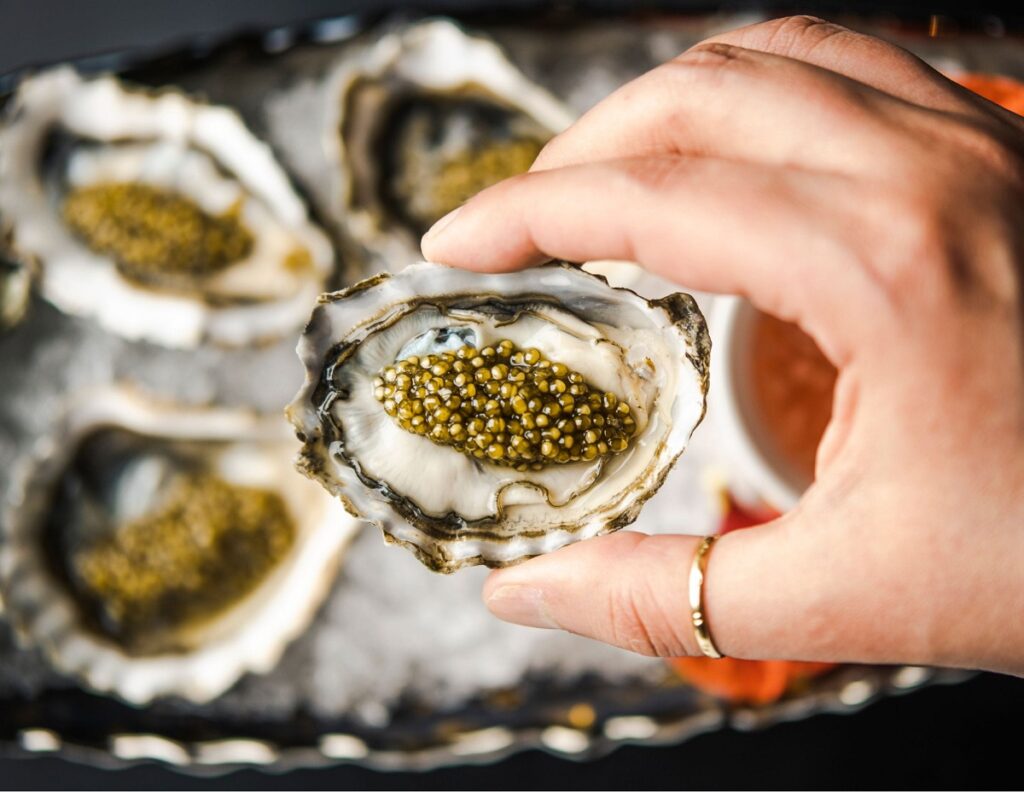Seafood 101:
What Is Considered Seafood?
When we think of seafood, we typically think of crab, shrimp, and other shellfish farmed from the ocean. What you may not know is that the category of seafood is much broader than just shellfish. The Food and Drug Administration classifies all commercially farmed freshwater and saltwater fish, molluscan shellfish, and crustaceans as seafood. It may come as a surprise to many people, but yes, even freshwater fish can be considered seafood.
Come Join Us For a Seafood and More Dinner You Won’t Forget! Book your reservation today!
Types of seafood
Saltwater Fish
Saltwater fish is just as it sounds, fish from bodies of salt water. Saltwater fish can live in oceans, seas, or brackish water. This fish type is typically fattier than freshwater fish, which is where those great omega-3 fatty acids are found. Tuna, salmon, halibut, and cod are a few of the most popular saltwater fish available. Saltwater fish tend to have a briny or saltier taste than freshwater fish, given their natural habitat.
Freshwater Fish
On the other end of the spectrum, we have freshwater fish. These fish are found in freshwater habitats like rivers, lakes, and streams. If you’re on the hunt for a lighter option for dinner or want to expand your palette to include fish, freshwater fish is a good choice because of its milder flavor. Many restaurants serve trout, bass, and catfish because they are popular freshwater fish choices.

What are the health benefits of seafood?
The health benefits of seafood are vast. Seafood is rich in Omega-3 fatty acids and is a prime form of protein. Studies have indicated that eating seafood two to three times per week reduces the risk of death from any health-related causes by 17%. The recommendation for seafood consumption is 6 ounces of seafood per week to improve overall health.
Seafood is also a great way to get DHA. This is especially important for pregnant women. DHA has been tested and shown to improve health outcomes in infants. Science supports the benefits of eating seafood on brain development in unborn babies.
We are all aware that our daily food choices and lifestyle influence not only our physical health but our mental health as well. There is strong evidence to support the claim that seafood is brain food. Individuals who eat seafood regularly are 20% less likely to develop depression.
We could write page after page of the health benefits and the evidence to support the fact that seafood is a prime way to improve overall health. You could go out and buy one of the thousands of supplements or health products on the market that claims to be superior for their health benefits. Why take the chance of being deceived or spending ridiculous amounts of money when you have a natural food option – with science to support its benefits. With the wide variety of seafood dishes available, even the pickiest eaters can find a seafood dish they love.
Looking for great seafood restaurants in Las Vegas? Aqua Seafood & Caviar Restaurant is a prime choice to start your journey to getting healthy with seafood.
What are healthy seafood options?
Shellfish
Shellfish are generally what comes to mind when we think of seafood. Shellfish is any organism farmed from the water with a shell: shrimp, crab, lobster, etc. While these are aquatic invertebrates and technically not fish, shellfish is used as an umbrella term for a wide variety of shelled organisms that originate in the water.
Mollusks
Mollusks fall under that umbrella term of shellfish we just mentioned. Mollusks are aquatic animals such as clams, oysters, and scallops. These invertebrates can be served raw, cooked, or smoked.
Crustaceans
Crustaceans, like mollusks, fall under the category of shellfish. These are the common forms of seafood that typically come to mind when the subject arises. These shellfish are animals such as crabs, lobsters, and shrimp. Crustaceans are a fan favorite not only because they are delicious but because of their versatility in the culinary world.
Cephalopods
Squid, octopus, and cuttlefish would fall under the category of cephalopods. These aquatic creatures are considered a delicacy and can be served raw or cooked. They are popular as sushi in some areas and many have enjoyed the fried crispy dish of calamari.
Roe
This type of seafood is better understood as the eggs of fish or other aquatic creatures. I’m sure caviar comes to mind when you think of fish eggs. Although caviar is considered roe, not all roe is caviar. To be caviar, the eggs must come from Acipenseridae, the sturgeon family. Roe can be supplied fresh, frozen, or canned. It is another popular ingredient in sushi.
Echinoderms
Urchins, sea cucumbers, and starfish are edible aquatic creatures known as echinoderms. In Peru, Japan, France, and Spain, echinoderms are considered a delicacy. Many describe these aquatic delicacies as soft and melting.
For more information on the various types of seafood, read our article specifically dedicated to the topic: Seafood 101: Types of Seafood
Want to try different types of seafood for yourself rather than read about it? Join us for dinner at Aqua Seafood & Caviar Restaurant for Seafood and More on the Vegas Strip!
There are a number of factors that influence the health benefits of seafood. You shouldn’t assume that all seafood dishes alone are going to have a significant impact on your health. Factors such as the freshness and type of fish, how it’s cooked, and what else is in the dish all contribute to the health benefits of seafood.
To reap the health benefits of seafood to its full extent, you will want to avoid deep-fried fish. Baked or pan-fried seafood is a much healthier alternative. You will also want to ensure that the other ingredients in the dish don’t take away from the health benefits of your seafood.
One great seafood option is salmon. Salmon is a staple ingredient in many healthy seafood dishes. Fresh fish, in general, is high in omega-3 fatty acids and vitamins D and B2. They are also rich in calcium, phosphorus, iron, zinc, iodine, magnesium, and potassium. Salmon typically has lower mercury content than other fish options, making this seafood option a top choice among healthy lifestyle advocates.
Shrimp is another excellent seafood option to improve health. It is low in calories, contains approximately 20 grams of protein, and contains high levels of iron, zinc, and omega-3. It also has the added benefit of being quick and easy to prepare.
Don’t forget about crab! Crab is also low in calories and high in protein. Plus, you gain the added benefit of 350-400 milligrams of Omega-3 fatty acids.
Another great seafood option for those who don’t particularly care for the taste of seafood is cod because of its exceptionally mild flavor. This option, like the others, is low in calories and high in protein, with the added benefit of no total or saturated fat.
Start your seafood journey today.

If you’re not sure where to start on your seafood journey, Aqua Seafood & Caviar Restaurant can help. We pride ourselves on our culinary art and offer a dining experience you won’t forget. Come join us for dinner and see what seafood in Las Vegas is all about.

